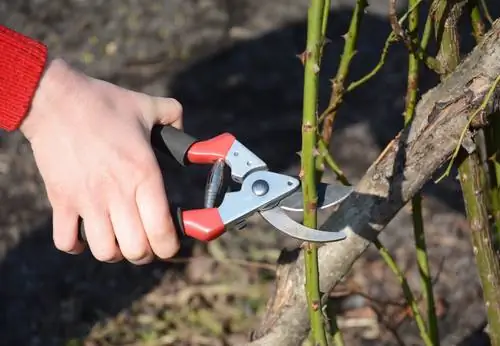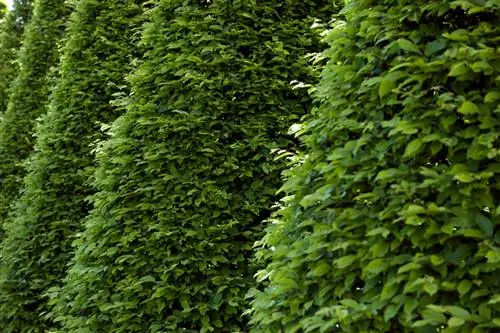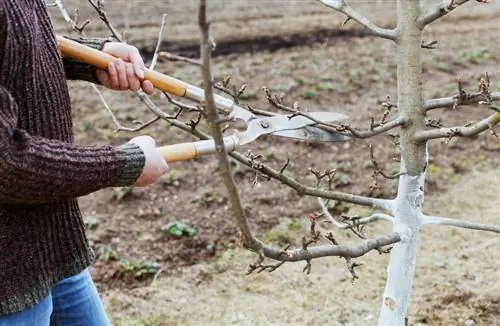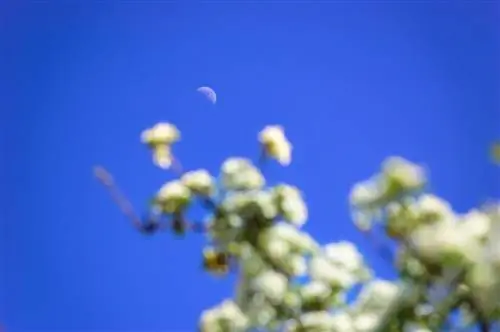- Author admin [email protected].
- Public 2023-12-16 16:46.
- Last modified 2025-06-01 06:02.
A rose bed presents itself in opulent Sunday attire if the gardener knows how to care for the pruning correctly. This tutorial will familiarize you with the basics of cutting roses. Comprehensible instructions explain the pruning procedure for important rose classes.
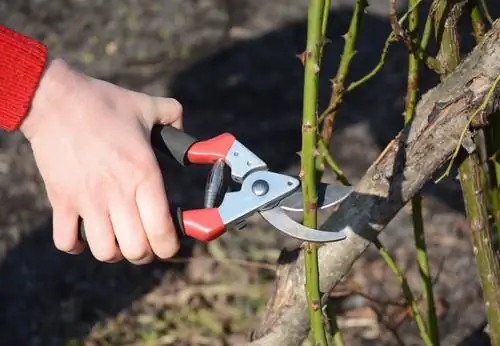
When and how should you cut roses?
Dead, frozen and damaged rose branches should first be thinned out or cut back. As soon as the forsythia blooms, weak shoots are pruned heavily and strong shoots less so. The topmost buds on the shoot should always face outwards. They sprout the most.
Important rose classes at a glance
More than 30,000 varieties of roses compete for the favor of gardeners. In order not to lose track of selection and care, the classification according to rose classes serves as a helpful guideline. The main distinguishing criterion is the growth habit, which also influences pruning care. A global classification system is not yet available. Furthermore, modern varieties cannot always be clearly assigned. After all, the following table with important rose classes offers practical guidance for private rose gardeners:
| Noble roses (hybrid tea) | Flower roses | Shrub roses | Dwarf roses | Ground cover roses | Climbing Roses (Climber) | Wild Roses | |
|---|---|---|---|---|---|---|---|
| Growth height | 60 to 130 cm | 60 to 100 cm | up to 250 cm | 20 to 40 cm | 30 to 50 cm | up to 500 cm | 100 to 250 cm |
| Flowering time | June to September | June to October | from mid-May/mid-June for 6 to 7 weeks | June to September | June to September/October | June to October/November | June to July/August |
| Flowering frequency | flowering more often | flowering more often | flowering once or more | flowering more often | flowering more often | flowering more often | flowering once |
| Growth habit | tightly upright | bushy, upright | upright to arched overhanging | compact, upright | long, flat to creeping | climbing (trellis required) | upright to broadly bushy, overhanging |
| Cutting time(s) | Spring and Summer | Spring and Summer | Spring and Summer | Spring and Summer | every 2-3 years in spring | Spring and Summer | Winter |
In addition to the two traditional cutting dates in spring and summer, an autumnal time is coming into focus. A separate tutorial explains the conditions under which rose gardeners resort to scissors again in autumn.
Basic rules for rose pruning
The basic basics of pruning care include that a rose gardener is familiar with important basic rules. These premises apply regardless of which class of roses thrives in your garden. To get you started, our basic tutorial introduces you to the fundamental principles for cutting roses in a nutshell:
- Prune roses every year when the forsythia blooms
- Thimout or cut back dead, frozen and damaged branches in advance
- Cut strong shoots little, cut weak shoots heavily
- Second and third order side shoots are the most valuable flower wood
- Buds in the top position always sprout the strongest
- Always remove weak branches at the base
- The top bud on the shoot should always face outwards before and after cutting
The most lush flowering occurs - depending on the rose class - on theone- and two-year-old shoots In order for a cut to achieve the optimal flower yield, it should produce as many second and third order branches as possible. The image below illustrates how to correctly distinguish the shoots of a rose according to their hierarchy. First-order shoots sprout directly from the main shoot. A first-order side shoot branches into second-order side shoots and so on. Once you understand the hierarchy and basics, you can't go wrong when cutting roses.
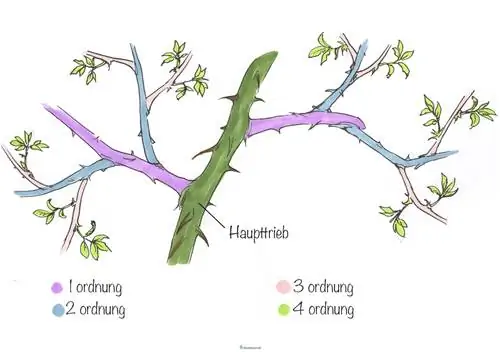
The hierarchy among the side shoots dictates the correct cut. The focus is on second and third order shoots as valuable flowering wood.
Background
Cutting circumference dictates growth power
A fundamental finding in tree pruning says: the stronger the pruning, the stronger the shoots. The reason for this law is the juice pressure. With each cut, the sap pressure underneath the cut increases because there is less shoot mass to supply. If you only cut off the shoot tip, the change is minimal. However, if you cut half or two thirds of a rose shoot, the plant sap and nutrients will accumulate massively. Sleeping eyes are then activated and happily move out. Measure the amount of rose cutting according to this rule of thumb: cut a strong rose a little - cut a weak rose heavily.
Cut roses vigorously
Pruning of noble roses aims at the formation of numerous long and straight flower stalks. Majestic flowers are enthroned at their tips in summer. A branching that is too dense is just an annoying disruptive factor. The illustration below shows that noble roses benefit from vigorous pruning. With the following cut you can direct the growth in the desired direction in spring and summer:
- First cut back all stronger shoots to 5 eyes, weak shoots to 3 eyes
- Short side shoots to 1 to 2 buds
- Onslow-growing onesNoble roses3 to 4 select the most promising shoots
- Onstrong-growing onesNoble roses5 to 6 select the best specimens
- Remove all remaining branches at ground level
- In summer, cut back withered branches down to the first leaflet with 5 partial leaves
Continuous rejuvenation works to prevent aging and the unfavorable leggy growth. For this purpose, thin out the oldest ground shoot at the base of old roses every spring.
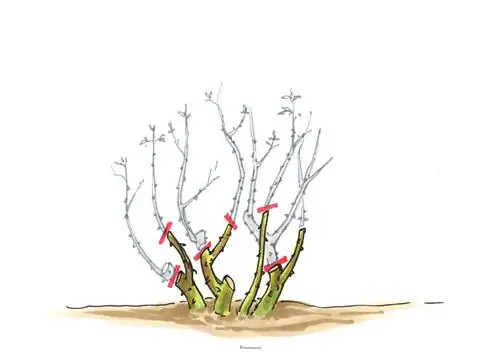
Cut your noble roses back to three to five buds. Weak-growing varieties should have a maximum of 4 shoots, while strong-growing varieties should have a maximum of 6 shoots. On old roses, remove the oldest shoot at ground level to ensure continuous rejuvenation.
Coordinate floribunda rose pruning with vigor
With five to seven ground shoots, floribunda roses are well positioned for a long, lavish flowering period. The aim of pruning care is to promote the valuable flower wood and keep long shoots under control. If excessively long shoots protrude from a rose bush, the bed rose will sooner or later fall apart. How to get the perfect cut:
- Short all shoots to 3 to 5 buds
- Leave 3 he althy shoots with 3 buds on a weakly growing floribunda rose
- Leave 5 he althy shoots with 5 buds on a strong-growing floribunda rose
- Clean out wilted inflorescences in summer down to the first leaf
In order for roses to show the desired reaction to a cut, the correct cut is important. The illustration below shows where and how to cut floribunda roses and other types of roses. Place the scissors five to 10 millimeters above an outward-facing bud. If you cut too short, the bud will be injured and will never sprout. If you cut too far away, a dried stump forms as an entry point for pathogens.
If a bed rose gets old, the annual thinning out of an old ground shoot provides new courage to live. In the last step of the main cut, cut off an old branch near the ground. The resulting sap buildup encourages young wood to venture into the light.
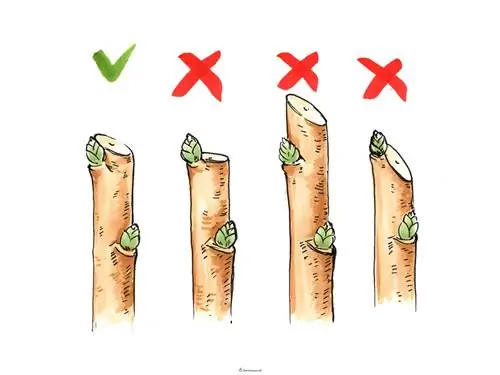
Always cut a rose shoot 5 to 10 mm above a clearly visible bud that faces outwards. Holding the rose scissors slightly at an angle prevents rain or irrigation water from drowning the bud
Cutting shrub roses that bloom more often
Shrub roses build a stable framework in the first few years. This consists offive to eight ground shootswithfirst and second order side shoots This creates the floral foundation for vital annual shoots with numerous flowers. In parallel with the construction of the scaffolding, pruning care works to prevent baldness from below from the start. With this cutting strategy the plan succeeds:
- Long shoots 1st order from the previous year: cut back bya third
- Shoots 2nd and 3rd order: shorten to 3 to 5 buds
- According to the space in the bed: leave a maximum of 8 vital ground shoots
- Thinning out: surplus, weak, aging ground shoots
The correct decision about the number of ground shoots depends on two aspects. The more airy a shrub rose is structured, the quicker its leaves dry off after a rainstorm. Historical, more frequently flowering shrub roses with thinner shoots also thrive. These collapse under the weight of magnificent flowers. By having a denser network of branches supporting each other, the risk is avoided. Modern varieties have more stately shoots with a larger diameter and cope excellently with three to five scaffold shoots.
Excursus
Constantly remove wild shoots
The most beautiful roses for beds and balconies are grafted onto a robust, vigorous wild base. It is precisely this vigor that can cause problems for your roses. The rootstock vehemently drives out wildlings that compete with the noble part for light, nutrients and water. The unwanted type of shoot can be identified by its foliage. Cultivated roses thrive with leaflets of three, five or seven individual leaves. In contrast, the leaves of wildlings are composed of up to fifteen individual leaves. If you have discovered a wild shoot, tear it off with a courageous tug.
Cutting single-blooming shrub roses
The pruning of shrub roses that bloom once differs significantly from their more frequently blooming counterparts. As a rule, these are historical varieties from the 19th century, such as the legendary “Queen of Denmark” from 1816 or “Mme. Hardy” from 1832. The floral divas place their flower buds on the previous year’s wood. For this reason, the main pruning takes place in summer. In the spring, once a shrub rose has bloomed, it is simply shaped. How to prune with gardening expertise:
- End of February/beginning of March: Shorten shoot tips to bush level, cut off rose hips
- July/August: Excessively long shoots divert to a deeper side shoot
- Ideally cut to 5 or 10 cm below this year's inflorescence
- In addition, from the 4th or 5th year, thin out an aging scaffold shoot
Some lovers of once-flowering historical varieties do not cross their roses at all. These shrub roses achieve impressive dimensions that are significantly larger than those stated in historical sources. In this case, the roses should be thinned out thoroughly at least every five to six years. Furthermore, it is recommended to rejuvenate heavily branched shoot tips by using the derivation cutting technique.
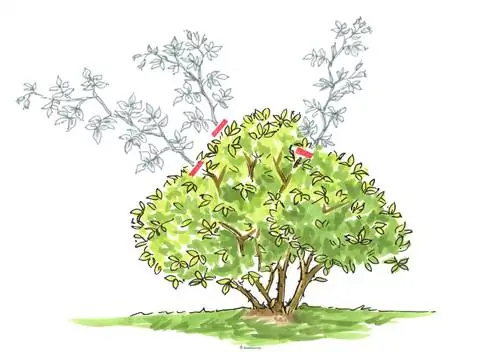
When shrub roses only bloom once, they produce their flower buds in late summer. Cut back this year's long shoots in August so that more short flower shoots form for next year.
Cut dwarf roses boldly
Dwarf roses appear big in summer with a sea of colorful flowers under which the leaves and shoots almost disappear. The little beautiesbloom on this year's branchesseveral times per season and do not form a supporting structure. The primarilyweak growthrequires astrong pruning so that a lush, blooming rose bush in small format develops every year. This is how it works:
- Intersect all 1st order shoots
- Growly variety: shorten to 6 to 7 buds
- Weak variety: cut back to 3 to 4 buds
- Finally, select 5 vital ground shoots and cut off all others at ground level
The summer care cut is dedicated to the withered flowers and is not limited to a single appointment. Rather, your dwarf roses will shine in picturesque splendor if you continually cut out everything that has faded. Only when the flowering period has definitely ended do you cut back the dead shoot tips back to the first he althy leaf.
Tip
In regions with harsh winters, rose gardeners prefer varieties that bloom more often. Roses that bloom once produce their flower buds the previous year and must be left over the winter undamaged. A harsh winter can destroy the valuable flower systems in just one night. Roses that bloom several times avoid this shortcoming because they primarily plant their buds on this year's shoots.
Cut ground cover roses every 3 years
It's really no fun to cut an area covered in thorny tendrils. It's a good thing that ground cover roses only need to be noted on the pruning care schedule every 2 to 3 years. The particular advantage of this class of roses is that the bushes sprout and bloom even without summer trimming, provided all other conditions are right. How to cut ground cover roses correctly:
- Prune every 2 to 3 years when the forsythia is blooming
- Thoroughly thin out the bushes in advance
- Short third order shoots to 3 to 5 buds
- Do not intersect second and first order shoots
If shoots grow beyond the intended bed area, shorten them to just above a bud. In the end, each main shoot on a ground cover rose should have at least two to three side shoots from which the flowering wood can sprout.
Background
Plant pruning - prologue to pruning care
Late winter maintenance pruning and summer care pruning are not the only important types of pruning for your roses. In connection with planting, subject the young roses to a planting cut. Before planting, shorten the roots of bare-rooted products to a length of 20 to 25 cm. Damaged shoots are removed on Astring. In the first spring, cut all branches to three to five buds. Do the same for container goods, although the roots remain untrimmed.
Form climbing roses on the trellis
The climbing roses that bloom more often are unsurpassed champions when it comes to vigor and abundance of flowers. If a stable trellis is available, the roses transform facades, arbors and arches into a summer floral fairytale. The right cut plays a key role in floral splendor. It is important to cover the climbing aid evenly and to attract numerous flowers. With this cut you can do it:
- Ideally, remove all or as many tendrils as possible from the climbing aid and place them on the ground
- On each main shoot: cut back all 2nd and 3rd order side shoots to 3 to 5 buds
- He althy, well-developed long shoots from the previous yeardo not cut
The cut main shoots now resemble a “chicken ladder” and are fixed to the climbing aid. The figure below illustrates the before/after effect. Start the formation with the most promising shoot and work your way up step by step. You may not need all of the main shoots, so you can end up removing the weakest ones. Annual long shoots, on the other hand, are the floral hope for your climbing rose and are spared from the scissors.
Pruning wild roses rarely
Wild roses are an enrichment for every natural garden. The rosy natural beauties are not designed for annual pruning care. Attempts to press a wild rose into a cutting shape are doomed to failure. A single ground shoot remains vital and blooming for up to six years. To prevent wild roses from turning into an old, impenetrable thicket, they need to be pruned every four to five years to keep them tidy. This is how a wild rose stays young and full of flowers for many years:
- The best time is in February when the weather is frost-free
- Throw out a third to a quarter of the old scaffold shoots (very dark wood) level with the ground
- Excessively long or overhanging shoots slim down to an outward-facing side shoot
- Do not cut annual, unbranched ground shoots
If young, green wood is in short supply in a wild rose, cut back some of the older, two to three year old shoots to 40 centimeters. This creates a sap that encourages sleeping eyes to sprout. If the cut branch gets caught in the dense weave, please do not use force when pulling it out. The risk of valuable flower wood being damaged is too great. Instead, cut up the old wood to make it easier to get hold of.
Pruning tool for rose cutting
A rose gardener always has his rose scissors at hand because they are the most important tool. The basic equipment also includes loppers and a folding knife. There are a variety of designs to choose from on the market. The following overview summarizes the basic properties that the cutting tool should have:
Rose scissors and pruning shears
- Narrow tip for maneuvering in tight spaces
- Two sharp blades as bypass scissors
- Constructed from high quality stainless steel or carbon steel
- Easy to dismantle for cleaning work
Pruning saw, folding saw
- Narrow, pointed saw blade
- Ideally with Japanese perforation
- Folding saw with stable locking
- Easy replacement of a dull saw blade
You won't be able to meet the high standards of your roses with cheap tools from discount stores. Please look at proven brand manufacturers such as Okatsune, Fiskars, Felco or Kumamoto. The investment in premium quality is rewarded with a smooth process of cutting work, so that you can fully concentrate on the perfect procedure.
Frequently asked questions
What does ADR rose mean?
ADR stands for Recognized German Rose and is to be understood as a seal of quality. The title is only awarded to those roses that were planted in one of eleven inspection gardens and impressed with their he alth and high ornamental value over a period of three to four years. One of the most important premises is that he althy growth can be achieved without the use of pesticides. Other criteria include winter hardiness, leaf he alth, self-cleaning and overall impression. So far, around 150 varieties have achieved the ADR rose designation.
When is the best time to plant roses?
You can plant roses grown in containers in beds or containers throughout the entire growing season. For bare root crops, the planting window is open from October to March. This applies provided that the earth is not frozen and the thermometer is above freezing.
My heart bleeds to cut my roses as hard as you can read in many instructions. Why should a rose be cut so deeply?
You are not alone with your concerns. Many rose lovers struggle with radically cutting back roses in spring. Hobby gardeners often assume that it takes too much energy for a rose if it has already started budding. In reality, roses only sprout at the end of a branch. Aging and lignification are inevitable if the shoots are not shortened regularly. Without annual pruning care, the flowering trees become increasingly bare from the base with a few flowers at the top.
When and how should I trim a standard rose?
Standard roses are the combination of the root and trunk of a wild rose, refined with a bed, shrub or noble rose as a crown. Cut the crown back to 20 to 40 centimeters in spring. If it is a dwarf rose crown, shorten the branches to 10 centimeters. An exception applies to cascade roses that bloom once. The crowns bloom on the previous year's wood and should only be thinned out and lightly cut into shape. Please make sure that you do not cut into the spherical grafting area that is in the transition from the trunk to the crown.
The 3 most common cutting mistakes
The Queen of Flowers graciously forgives many a beginner's mistake. When making the following three pruning mistakes, hobby gardeners usually fall into disgrace and, in the worst case, are punished with the complete failure of their roses. The following table names common mishaps, provides information about typical damage and has tips for prevention:
| Cutting errors | malicious image | Prevention |
|---|---|---|
| never cut | premature aging, bare thickets, few flowers | prune every year when the forsythia blooms |
| cut somewhere | Growth depression, dried buds, spread of diseases | Cut 5-10 mm above a bud |
| cut too timidly | bare base, massively branched, flower-poor shoot tips | cut back to 3 to 5 buds in spring |

Tip
A regular and balanced supply of nutrients is the optimal complement to expert pruning care. To ensure that roses bloom lavishly, apply a special organic-mineral rose fertilizer at the end of March and the end of June. Please pay attention to the dosage. Too much of a good thing makes roses soft and vulnerable. It shouldn't be more than 60 grams per square meter.

